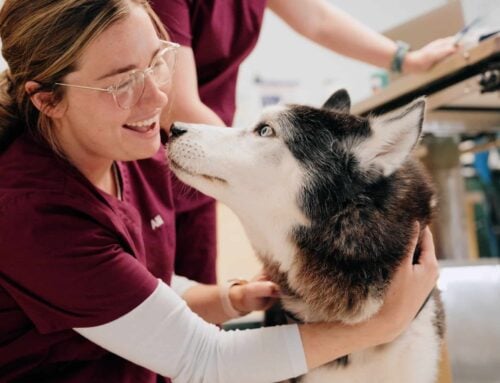May is Arthritis Awareness Month. Dogs and cats suffer from this painful inflammatory disease, just like humans. It is important to know that because osteoarthritis is a degenerative joint disease, it cannot be cured, but only controlled. The pain of arthritis comes from the loss of cartilage which normally acts as a healthy shield, covering and supporting each joint in the body. When the joint becomes unstable, the threat of arthritis emerges. These instabilities in the joints can be caused either through trauma, congenital issues (like hip dysplasia or luxating patellas), metabolic disturbances, or serious illness. This is why early detection is critical. Your pet does not have to be old to have, or show signs of having, this condition. Often times, there is an active flare up, causing pain and inflammation. The disease process still continues after the pain and inflammation have been handled, either naturally by the body, or by pet physical therapy and rehabilitation administered by a veterinarian.
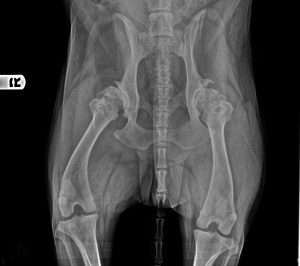 Image courtesy of Mount Pleasant Animal Hospital
Image courtesy of Mount Pleasant Animal Hospital
This complex series of events takes place on a microscopic level, but if left untreated it can have a huge impact on your pet! The joint starts to deteriorate, chronic pain ensues, and your pet begins to compensate by changing their lifestyle patterns. To the untrained eye, this deviation may appear to be a normal, age-related, slow down, but that conclusion may be wrong! Instead, we may be dealing with arthritis. If it is arthritis, how can we be sure? Careful examination and a good history from our pet parents help us determine what is happening in your pet. Cats may be especially elusive to diagnose because the limp, readily seen in dogs with this condition, can manifest as a crouched walk in felines. Sometimes, we use radiographs, or X-rays, to see the physical changes of the joint. 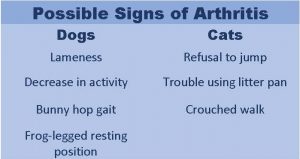 These changes can show up as bone remodeling (like those seen in the knuckles of human patients with arthritis) or joint effusion (present in the swollen knees of human arthritic patients). Your pet may not want to go on walks as much as they used to, but exercise is crucial to maintaining joint health for a long as possible. Without exercise, the body’s metabolism can drop and result in obesity. This extra weight puts extra stress and strain on the joints, thus encouraging even less activity, perpetuating the problem. For dogs diagnosed with osteoarthritis, start with regular, controlled, 20-minute, daily walks on flat surfaces. Cats can be encouraged to exercise similarly, using puzzle toys and/or food around the house, driving them to move around or “hunt” to find their “prey”. Keep in mind, this is only if the patient is pain free. Cats and dogs need to be put on suitable diets, keeping them trim, and promoting joint health with added omega -3 fatty acids, glucosamine hydrochloride, chondroitin sulfate, and egg shell membrane. We can help calculate the amount of Kcals per day your pet needs to begin their weight loss journey or for maintaining a healthy weight. Remember, healthy weight, healthy gait!
These changes can show up as bone remodeling (like those seen in the knuckles of human patients with arthritis) or joint effusion (present in the swollen knees of human arthritic patients). Your pet may not want to go on walks as much as they used to, but exercise is crucial to maintaining joint health for a long as possible. Without exercise, the body’s metabolism can drop and result in obesity. This extra weight puts extra stress and strain on the joints, thus encouraging even less activity, perpetuating the problem. For dogs diagnosed with osteoarthritis, start with regular, controlled, 20-minute, daily walks on flat surfaces. Cats can be encouraged to exercise similarly, using puzzle toys and/or food around the house, driving them to move around or “hunt” to find their “prey”. Keep in mind, this is only if the patient is pain free. Cats and dogs need to be put on suitable diets, keeping them trim, and promoting joint health with added omega -3 fatty acids, glucosamine hydrochloride, chondroitin sulfate, and egg shell membrane. We can help calculate the amount of Kcals per day your pet needs to begin their weight loss journey or for maintaining a healthy weight. Remember, healthy weight, healthy gait!
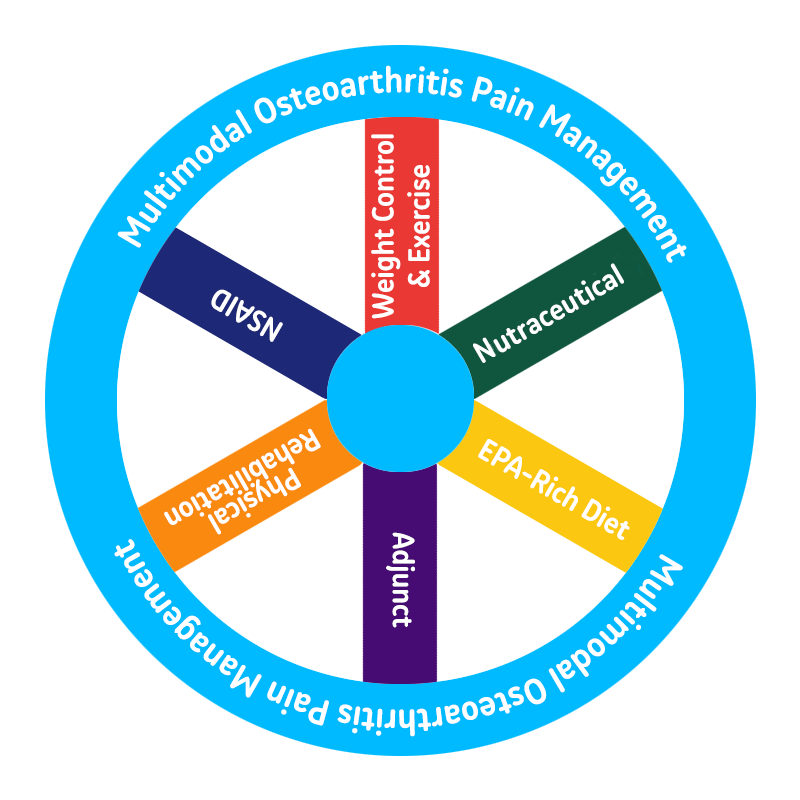
Handling the pain of arthritis is so important! Research shows there is not one, single way to do this. Instead, we employ a multimodal approach to pain management. We use several types of non-steroidal anti-inflammatory drugs, for both dogs and cats, to help stop arthritic flare-ups. We also work to block the neurological pathways of chronic pain, using medications that limit the amount of pain the brain registers on a daily basis. If they can feel better, their whole demeanor often changes. This can be seen through more interaction with their owners, less grouchy, eating more OR less depending on past habits, wanting to play more, or simply spending less time sleeping. These are all signs that pain and inflammation are being controlled.
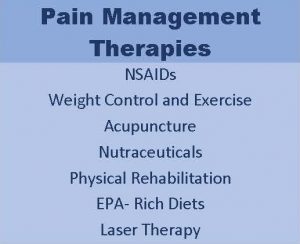 Occasionally, there are patients that need a few more spokes added to their wheel, and we are more than happy to help! Not only do we use food, joint supplements, NSAIDS, pain-receptor blockers, and exercise plans in our multimodal pet pain management, wheel but, when needed, we have the ability to add a regimen of organized physical therapy exercises. Dr. Shuler Holladay can tailor a rehabilitation plan that is just right for your dog or cat. She utilizes treadmills, e-stim, pet cold laser therapy, and hot and cold therapy to help find your pet’s best health plan for arthritis control. The diagnosis of arthritis can be scary to hear, but with early diagnosis and our comprehensive approach to therapy, your pet has an outstanding chance of living a healthy, happy, and comfortable life!
Occasionally, there are patients that need a few more spokes added to their wheel, and we are more than happy to help! Not only do we use food, joint supplements, NSAIDS, pain-receptor blockers, and exercise plans in our multimodal pet pain management, wheel but, when needed, we have the ability to add a regimen of organized physical therapy exercises. Dr. Shuler Holladay can tailor a rehabilitation plan that is just right for your dog or cat. She utilizes treadmills, e-stim, pet cold laser therapy, and hot and cold therapy to help find your pet’s best health plan for arthritis control. The diagnosis of arthritis can be scary to hear, but with early diagnosis and our comprehensive approach to therapy, your pet has an outstanding chance of living a healthy, happy, and comfortable life!


